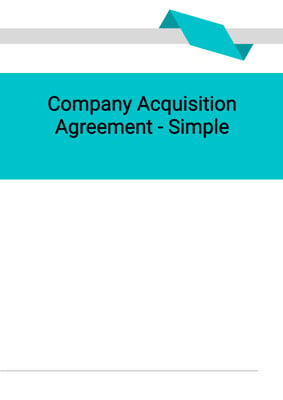How to Tailor the Document for Your Need?
01
Create Document
Fill in the details of the parties. You can click the "Fill with Member’s Information" button to complete it with information saved to your account.
02
Fill Information
Please fill in any additional information by following the step-by-step guide on the left hand side of the preview document and click the "Next" button.
03
Get Document
When you are done, click the "Get Document" button and you can download the document in Word or PDF format.
04
Review Document
Please get all parties to review the document carefully and make any final modifications to ensure that the details are correct before signing the document.
Document Preview
Document Description
The Business Acquisition Agreement - Simple is a legal document that outlines the terms and conditions of the sale and purchase of a business. This agreement is entered into between the seller, who is the current owner of the business, and the buyer, who wishes to acquire the business. The document begins with a brief introduction, highlighting the importance of the agreement in facilitating the transfer of ownership and ensuring a smooth transition for both parties.
The agreement is divided into several sections, each addressing different aspects of the sale and purchase. The first section provides definitions for key terms used throughout the document, ensuring clarity and understanding. The headings in the agreement do not affect its interpretation.
The second section, titled 'Agreement to Sell and Price', outlines the seller's obligation to sell and transfer the business to the buyer, and the buyer's obligation to purchase and take over the business. It specifies the assets included in the sale, such as properties, plant and equipment, working capital, trade debtors, business intellectual property rights, contracts, business claims, shares in subsidiaries or trade investments, and goodwill. The consideration for the sale is also detailed, whether it is a fixed amount of currency or the issuance of shares in the buyer's capital. The buyer assumes responsibility for the satisfaction of all liabilities.
The third section, titled 'Completion', describes the process of completing the sale and purchase of the business assets. It outlines the documents and tangible assets that the seller must deliver or make available to the buyer, including deeds and documents of title, possession of tangible assets, and counterpart originals of deeds of assignment. The buyer is required to pay the cash purchase price or issue a share certificate, depending on the agreed consideration. If any transfer documents are not available at completion, the parties must arrange for their preparation and completion as soon as practicable.
The fourth section, titled 'Title and Supplementary Provisions', addresses the passing of beneficial ownership and risk to the buyer upon completion. It also covers the transfer of contracts and claims that require novation or consent from third parties. The seller agrees to execute additional documents and take necessary steps to vest title to the business assets in the buyer.
If properties are included in the sale, the fifth section specifies that the parties must enter into transfer documents or other arrangements to pass the benefit of the seller's interests in the properties to the buyer. If employees are included in the sale, the sixth section acknowledges and agrees that the employees will be transferred to the buyer.
The seventh section, titled 'Entire Agreement', states that the agreement sets out the entire agreement and understanding between the parties regarding the sale and purchase of the business. It clarifies that neither party has relied on any representation, warranty, or undertaking not expressly set out or referred to in the agreement.
The eighth section, titled 'Counterparts', allows the agreement to be executed in any number of counterparts, with each counterpart constituting an original document.
The ninth section, titled 'Further Assurance', obligates the seller to perform or procure the performance of all acts and things necessary to implement and give effect to the agreement. This includes executing and delivering additional documents as required by law or requested by the buyer.
The tenth section, titled 'Severability', states that if any provision of the agreement is held to be invalid or unenforceable, it shall be deemed not to be included in the agreement without invalidating the remaining provisions. The parties must use reasonable endeavors to replace the invalid or unenforceable provision with a valid and enforceable substitute provision.
The eleventh section, titled 'Variation', specifies that no variation of the agreement shall be valid unless it is in writing and signed by or on behalf of each party. The term 'variation' includes any variation, supplement, deletion, or replacement of the agreement or any referred documents.
The twelfth section, titled 'No Rights of Third Parties', clarifies that a person who is not a party to the agreement has no right to enforce its terms.
The thirteenth section, titled 'Governing Law, Jurisdiction', states that the agreement is governed by the laws of the jurisdiction specified. It also includes a jurisdiction clause, specifying the courts or tribunals that have jurisdiction over any disputes arising from the agreement.
The agreement concludes with the signatures of the duly authorized representatives of the parties, along with the date of signing.
How to use this document?
1. Review the agreement: Familiarize yourself with the content and structure of the Business Acquisition Agreement - Simple.
2. Gather necessary information: Collect all relevant information, including the names and addresses of the seller and buyer, details of the business assets, consideration for the sale, and any specific provisions or requirements.
3. Customize the agreement: Modify the agreement to reflect the specific terms and conditions agreed upon by the parties. Ensure that all sections and clauses accurately represent the intentions of both parties.
4. Seek legal advice if necessary: If you have any doubts or concerns about the agreement, consult with a legal professional to ensure compliance with applicable laws and regulations.
5. Execute the agreement: Once the agreement has been reviewed, customized, and approved, arrange for the authorized representatives of both parties to sign the agreement.
6. Complete the sale and purchase: Follow the steps outlined in the 'Completion' section of the agreement to finalize the transfer of ownership and assets. Ensure that all necessary documents and tangible assets are delivered or made available to the buyer.
7. Fulfill further obligations: If any additional actions or documents are required to implement the agreement, promptly perform or procure the performance of those obligations.
8. Keep records: Maintain copies of the signed agreement, supporting documents, and any correspondence related to the sale and purchase of the business.
9. Resolve disputes: In the event of any disputes or disagreements, refer to the 'Governing Law, Jurisdiction' section to determine the appropriate jurisdiction and seek legal advice if necessary.
10. Update relevant parties: Inform relevant stakeholders, such as employees, customers, and suppliers, about the change in ownership and any necessary actions or arrangements resulting from the sale and purchase of the business.
Not the right document?
Don’t worry, we have thousands of documents for you to choose from:








